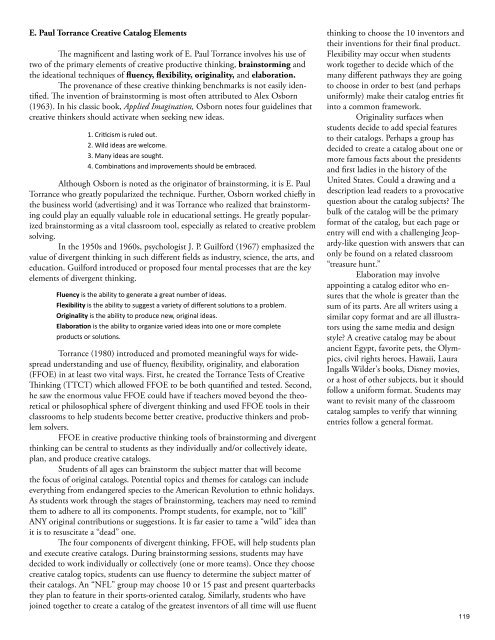Torrance Journal for Applied Creativity
TorranceJournal_V1
TorranceJournal_V1
You also want an ePaper? Increase the reach of your titles
YUMPU automatically turns print PDFs into web optimized ePapers that Google loves.
E. Paul <strong>Torrance</strong> Creative Catalog Elements<br />
The magnificent and lasting work of E. Paul <strong>Torrance</strong> involves his use of<br />
two of the primary elements of creative productive thinking, brainstorming and<br />
the ideational techniques of fluency, flexibility, originality, and elaboration.<br />
The provenance of these creative thinking benchmarks is not easily identified.<br />
The invention of brainstorming is most often attributed to Alex Osborn<br />
(1963). In his classic book, <strong>Applied</strong> Imagination, Osborn notes four guidelines that<br />
creative thinkers should activate when seeking new ideas.<br />
1. Criticism is ruled out.<br />
2. Wild ideas are welcome.<br />
3. Many ideas are sought.<br />
4. Combinations and improvements should be embraced.<br />
Although Osborn is noted as the originator of brainstorming, it is E. Paul<br />
<strong>Torrance</strong> who greatly popularized the technique. Further, Osborn worked chiefly in<br />
the business world (advertising) and it was <strong>Torrance</strong> who realized that brainstorming<br />
could play an equally valuable role in educational settings. He greatly popularized<br />
brainstorming as a vital classroom tool, especially as related to creative problem<br />
solving.<br />
In the 1950s and 1960s, psychologist J. P. Guil<strong>for</strong>d (1967) emphasized the<br />
value of divergent thinking in such different fields as industry, science, the arts, and<br />
education. Guil<strong>for</strong>d introduced or proposed four mental processes that are the key<br />
elements of divergent thinking.<br />
Fluency is the ability to generate a great number of ideas.<br />
Flexibility is the ability to suggest a variety of different solutions to a problem.<br />
Originality is the ability to produce new, original ideas.<br />
Elaboration is the ability to organize varied ideas into one or more complete<br />
products or solutions.<br />
<strong>Torrance</strong> (1980) introduced and promoted meaningful ways <strong>for</strong> widespread<br />
understanding and use of fluency, flexibility, originality, and elaboration<br />
(FFOE) in at least two vital ways. First, he created the <strong>Torrance</strong> Tests of Creative<br />
Thinking (TTCT) which allowed FFOE to be both quantified and tested. Second,<br />
he saw the enormous value FFOE could have if teachers moved beyond the theoretical<br />
or philosophical sphere of divergent thinking and used FFOE tools in their<br />
classrooms to help students become better creative, productive thinkers and problem<br />
solvers.<br />
FFOE in creative productive thinking tools of brainstorming and divergent<br />
thinking can be central to students as they individually and/or collectively ideate,<br />
plan, and produce creative catalogs.<br />
Students of all ages can brainstorm the subject matter that will become<br />
the focus of original catalogs. Potential topics and themes <strong>for</strong> catalogs can include<br />
everything from endangered species to the American Revolution to ethnic holidays.<br />
As students work through the stages of brainstorming, teachers may need to remind<br />
them to adhere to all its components. Prompt students, <strong>for</strong> example, not to “kill”<br />
ANY original contributions or suggestions. It is far easier to tame a “wild” idea than<br />
it is to resuscitate a “dead” one.<br />
The four components of divergent thinking, FFOE, will help students plan<br />
and execute creative catalogs. During brainstorming sessions, students may have<br />
decided to work individually or collectively (one or more teams). Once they choose<br />
creative catalog topics, students can use fluency to determine the subject matter of<br />
their catalogs. An “NFL” group may choose 10 or 15 past and present quarterbacks<br />
they plan to feature in their sports-oriented catalog. Similarly, students who have<br />
joined together to create a catalog of the greatest inventors of all time will use fluent<br />
thinking to choose the 10 inventors and<br />
their inventions <strong>for</strong> their final product.<br />
Flexibility may occur when students<br />
work together to decide which of the<br />
many different pathways they are going<br />
to choose in order to best (and perhaps<br />
uni<strong>for</strong>mly) make their catalog entries fit<br />
into a common framework.<br />
Originality surfaces when<br />
students decide to add special features<br />
to their catalogs. Perhaps a group has<br />
decided to create a catalog about one or<br />
more famous facts about the presidents<br />
and first ladies in the history of the<br />
United States. Could a drawing and a<br />
description lead readers to a provocative<br />
question about the catalog subjects? The<br />
bulk of the catalog will be the primary<br />
<strong>for</strong>mat of the catalog, but each page or<br />
entry will end with a challenging Jeopardy-like<br />
question with answers that can<br />
only be found on a related classroom<br />
“treasure hunt.”<br />
Elaboration may involve<br />
appointing a catalog editor who ensures<br />
that the whole is greater than the<br />
sum of its parts. Are all writers using a<br />
similar copy <strong>for</strong>mat and are all illustrators<br />
using the same media and design<br />
style? A creative catalog may be about<br />
ancient Egypt, favorite pets, the Olympics,<br />
civil rights heroes, Hawaii, Laura<br />
Ingalls Wilder's books, Disney movies,<br />
or a host of other subjects, but it should<br />
follow a uni<strong>for</strong>m <strong>for</strong>mat. Students may<br />
want to revisit many of the classroom<br />
catalog samples to verify that winning<br />
entries follow a general <strong>for</strong>mat.<br />
119


